|
A train wreck or train crash is a type of disaster
involving one or more trains. Train wrecks often occur as a result of
miscommunication, as when a moving train meets another train on the same
track; or an accident, such as when a train wheel jumps off a track in a
derailment.
|
|
Train shot across terrace after failing to brake
The Gare Montparnasse, one of six large Paris railway terminals, became
famous on October 22, 1895 for the derailment of the Granville–Paris
Express, which overran the buffer stop. The engine careened across
almost 30 meters (100 ft.) of the station concourse, crashed through a
60-centimeter (2 ft.) thick wall, shot across a terrace and smashed out
of the station, plummeting onto the Place de Rennes 10 meters (33 ft.)
below, where it stood on its nose. Two of the 131 passengers sustained
injuries, along with the fireman and two conductors. The only fatality
was a woman on the street below who was killed by falling masonry. The
accident was caused by a faulty Westinghouse brake and the engine
driver, who was trying to make up for lost time. A conductor was given a
25-franc fine and the engine driver a 50-franc fine. |
|
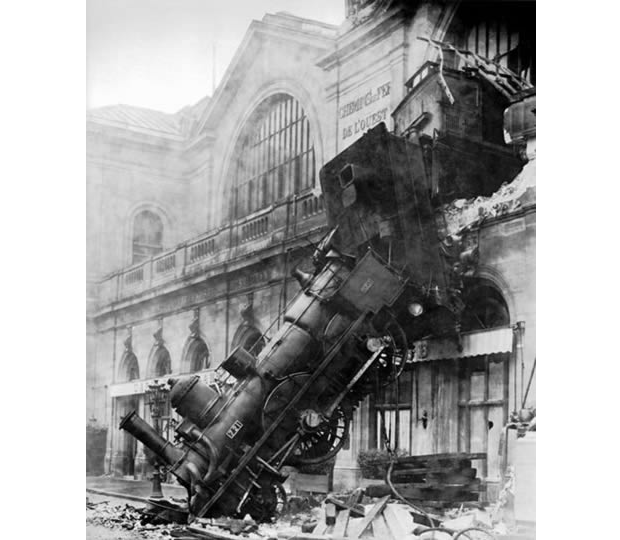 |
|
World's deadliest high speed train accident
The Eschede train disaster was the world's deadliest high-speed train
accident. It occurred on June 3, 1998 near the village of Eschede in the
Celle district of Lower Saxony, Germany. The toll of 101 people dead and
88 (estimated) injured surpassed the 1971 Dahlerau train disaster as the
deadliest accident in the history of the Federal Republic of Germany. It
was caused by a single fatigue crack in one wheel which, when it finally
failed, caused the train to derail at a switch. The intense destruction
of the train was due to a collision with a road bridge after the
derailment. |
|

|
|
World's most fatal rail disaster when train is hit by tsunami
The 2004 Sri Lanka tsunami-rail disaster was a rail disaster with the
highest death count in history. It occurred when a crowded passenger
train was destroyed on a coastal railway in Sri Lanka by the tsunami
which followed the 2004 Indian Ocean Earthquake, and resulted in the
greatest loss of life in railroad history. More than 1,700 people died,
much higher than the previous rail disaster with the most fatalities.
The train, known locally as the Queen of the Sea Line, was a regular
service train operating between the cities of Colombo and Galle. On
Sunday, December 26, 2004 it left Colombo shortly after 6:55 A.M. with
between 1,000 and 1,500 paid passengers and an unknown number of unpaid
passengers. At 9:30 A.M., in the village of Peraliya, near Telwatta, the
beach was hit by the first of the huge waves thrown up by the
earthquake, which had recently struck off the coast of Sumatra,
Indonesia. The train came to a halt as water surged around it. Hundreds
of local people, believing the train to be secure on the rails, climbed
on top of the train to avoid being swept away. Others stood behind it,
hoping the train would take the force of the water. The wave caused
flooding in the carriages and began to cause panic amongst the
passengers. The next, much larger, wave picked the train up and smashed
it against the trees and houses which lined the track, crushing those
seeking shelter behind it. The eight carriages were so packed with
people that the doors could not be opened, and they filled with water,
drowning almost everyone inside as the water washed over the wreckage
several more times. Estimations based on the state of the shoreline and
a high-water mark on a nearby building place the tsunami 7.5 to 9 meters
above sea level and 2 to 3 meters higher than the top of the train. |
|
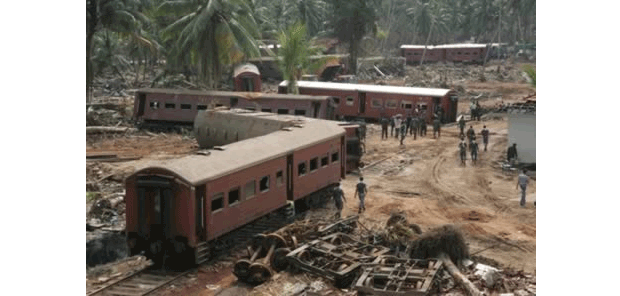
|
|
Train stolen and crashed into a house
Now, stealing cars, trucks and motorcycles are pretty common
occurrences, but stealing a train? That's not something you hear about
every day. A 20-year old woman, who works as a cleaner in Stockholm,
Sweden, did just that. She Stole the keys to a train, then drove it at a
high speed to the end of the track it was on and crashed it into a house
after leaving the line and jumping over a street. Luckily no one except
the unidentified woman was hurt. It was early in the morning so there
were no other passengers on the train and no one in the house was in the
line of fire. NOTE: It was determined later that the train wasn't
stolen. The cleaner accidentally turned it on while cleaning the cab and
couldn't work out how to turn it off. |
|
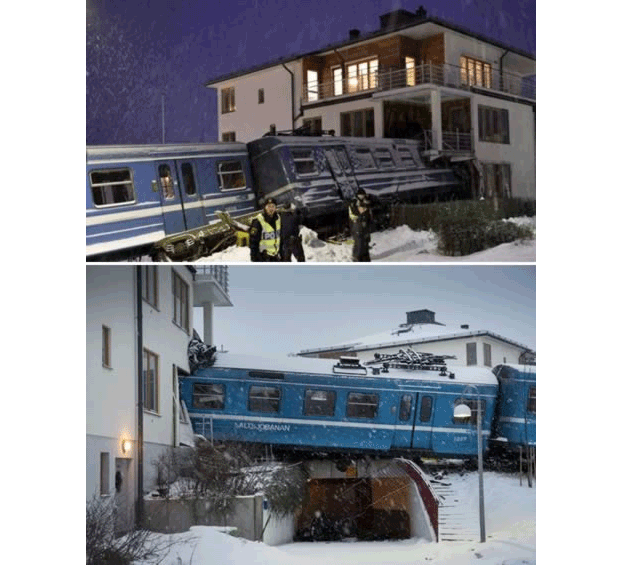 |
|
Unstoppable train caused bridge to collapse
The Lewisham rail crash occurred on the Lewisham by-pass line in London
at about 6:20pm on December 4, 1957. In dense fog, an electric train to
Hayes stopped at a signal under a bridge and the following steam train
to Ramsgate crashed into it, with the collision causing the bridge to
collapse onto the steam train. There were 90 fatalities and 109 people
were detained in the hospital. The bridge had to be cleared away and it
was over a week before the lines under the bridge were reopened, and
another month before the bridge was rebuilt and traffic was allowed over
it. The driver of the Ramsgate train was acquitted of manslaughter
charges after two trials. The Ministry of Transport report found that he
had failed to slow after passing two caution signals so he was unable to
stop at the danger signal, concluding that an automatic warning system
would have prevented the collision.
|
|
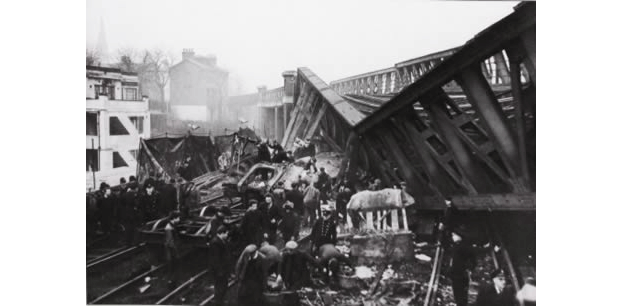 |
|
Train collision in India
The Firozabad rail disaster occurred in India in 1995 when two trains –
Kalindi express and Purshottam express - collided near Firozabad.
Purshottam express hit Kalindi express from behind when the latter had
to stop due to jammed breaks after hitting a cow. Almost all the people
were asleep when the collision tool place. Around 200 people were
reported dead and another 200 injured.
|
|
 |
|
Train wreck caused by drag race
The caption for this photo in William Middleton's The Interurban Era
reads:
Two Fonda, Johnstown, & Gloversville cars suffered embarrassment after
unsuccessfully contesting track space in the Gloversville (N.Y.) yard.
|
|
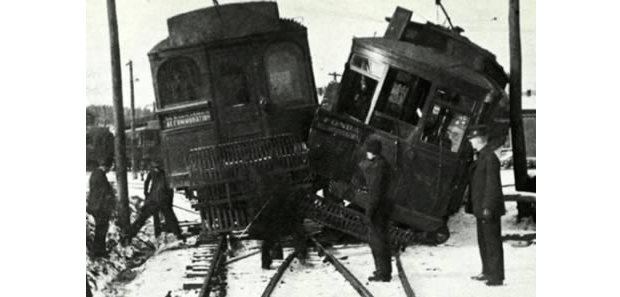 |
|
Miraculous train derailment with only one casualty
It was a tranquil setting in the heart of the picturesque Lake District.
But on a cold, rainy evening in February 2007, the peace at a farmland
near to the tiny village of Grayrigg was shattered when a Virgin
Pendolino London to Glasgow express train derailed on the West Coast
Main Line. In just a few seconds, eight carriages of the Class 390
tilting train were derailed and 86 passengers and two crew of the 105
people aboard were injured as the 95 mph locomotive came off the rails
and carriages scattered down an earth embankment. One person died,
84-year-old Margaret ‘Peggy' Masson, who survived the initial impact but
died later in hospital.
|
|
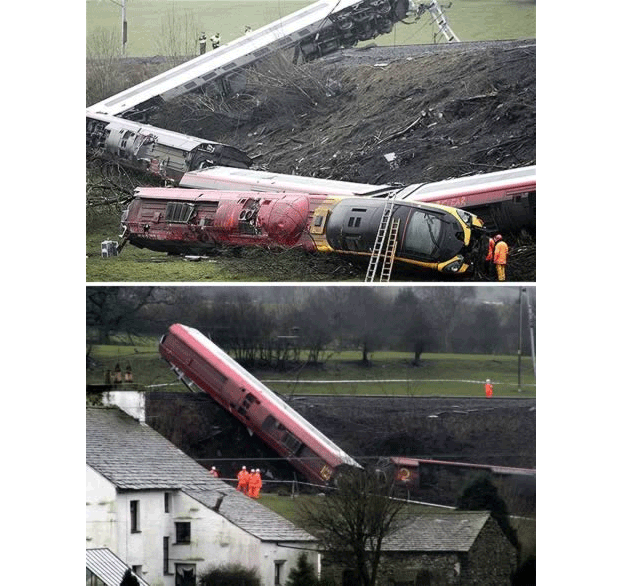 |